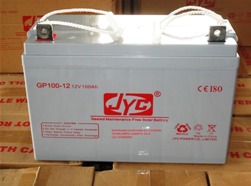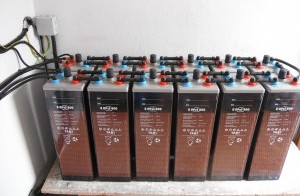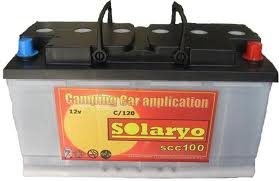Categories: Featured Articles » Autonomous power supply
Number of views: 32975
Comments on the article: 2
Batteries for solar panels
 In the solar energy sector, batteries occupy a special place, which play the role of an intermediary in the transfer of electrical power to end-users. This can be explained by the fact that the maximum amount of electric energy is generated by the solar battery during intense light exposure that occurs in the daytime.
In the solar energy sector, batteries occupy a special place, which play the role of an intermediary in the transfer of electrical power to end-users. This can be explained by the fact that the maximum amount of electric energy is generated by the solar battery during intense light exposure that occurs in the daytime.
However, its greatest consumption is carried out with the onset of darkness, when lighting with household appliances is massively used. Batteries allow you to save surplus electricity generated during the day for its evening and night use.
Of course, as an option, in the daytime you can turn off part of the working solar modules in the reserve, but this will not solve the issue of evening electricity shortages.
Battery Principle
Any electric batteries are considered as reusable direct current sources with the ability to perform reversible chemical processes by conducting multiple charge cycles with the passage of electric currents in the direction opposite to the reverse movement of elementary particles during discharge.
Why choose lead acid models
Statistical studies revealed that the work of the elite lithium batteries PRC production costs about $ 0.4 per 1 W / hour with a resource duration of 1000 ÷ 2000 charge / discharge cycles, which lasts for 3-6 years.
The cheapest, naturally, environmentally unsafe, lead-acid batteries are priced at $ 0.08 with approximately the same characteristics, but with an efficiency of ≈75% (they lose a quarter of the energy received).
These examples indicate the economic inexpediency of using expensive battery designs in home solar power systems.
We recommend also to see:
Gel batteries - device, application and features of use
Key Battery Performance
These include:
-
capacity,
-
energy density
-
self-discharge
-
temperature and atmospheric conditions
-
a type.
The battery capacity is determined by the amount of charge, which is measured when energy is supplied to consumers from a fully charged state to the minimum permissible value of the output voltage.
For international technical measurements, the SI system is used (the unit is “Pendant”). In practical activities in the territory of the CIS countries, it has long been a tradition to determine the battery capacity in ampere-hours with a standard ratio of 1A / hour = 3600Kl.
Now another similar characteristic has begun to be used - energy capacity, which implies the amount of energy given to consumers from a fully charged battery to achieve the state of minimum output voltage.
The unit of measurement in the SI system is "Joule", and in practice - watt-hour with a ratio of 1W / hour = 3600J.
Energy density takes into account the total amount of energy distributed per unit volume (or weight) of the battery. This parameter is used to compare the effectiveness of design features of different models.
Self-discharge is used to analyze the losses of the received charge at idle when there is no load. The term was introduced to assess the quality of work of a particular design during long-term energy storage.
The self-discharge performance of lead-acid batteries is estimated by the loss of 40% of capacity during annual storage at a temperature of +20aboutC or 15% at - +5aboutFROM.These examples clearly demonstrate an increase in self-discharge with increasing temperature.
In storage conditions +40aboutWith a loss of 40% capacity can occur after 4 months.
Temperature and atmospheric conditions
Batteries do not tolerate sudden changes in temperature, heating above +40aboutC and cooling lower than -25aboutFROM.
They cannot be kept near open flames due to the possibility of self-ignition of vapors or unintentional heating. The ingress of water and precipitation onto the battery is unacceptable due to the occurrence of self-discharge currents through additional electrical circuits.
The type of battery is determined based on the design of the housing:
-
requiring control of the electrolyte and restoration of its level during the boiling of vapors,
-
sealed models using a closed loop. They can be maintenance-free execution with a guarantee of work up to 5 years (sensitive to deep discharge and overcharge) or low-maintenance, requiring control and top-up of water twice a year.
Battery Charge Process
Battery operation is associated with a change in its internal chemical energy. Its supply is constantly reduced during discharge and leads to a decrease in current and voltage. To restore it, it is enough to skip a direct current of a higher voltage in the opposite direction.
In practice, it is customary to choose its value by the ratio: the numerical expression of 100% of the nominal capacity in amperes / hours is divided by 10 and the current value in amperes is obtained. This empirical value has no scientific justification, but is widely used for eight-hour charge cycles. However, it is best suited for NiMh and NiCd designs, rather than lead acid.
In solar power plants, charge is carried out during the duty cycle of the circuit.
The device and principle of operation of a solar power station was previously considered here:Solar Power For Home

Features of operation of batteries for solar batteries
Saving operating mode
The algorithms of the controller and inverter should provide maximum possibilities for transferring energy from solar modules to end users without the participation of working batteries, the resource of which should be carefully used only for storage and transfer of excess energy received by them.
Shaking protection
During movements and / or vibrations of the housing, leakage of electrolyte to the external surface is possible, which causes increased self-discharge. For its prevention, it is necessary to neutralize the resulting smudges with weak aqueous solutions of baking soda or laundry soap in a state corresponding to the type of liquefied sour cream.
Temperature effect
The high temperature of the battery leads to water evaporation: the density of the electrolyte increases and the output voltage rises. This process requires control - contact plates may be exposed. Therefore, it is necessary to regularly add distilled water to the control level.
At low temperatures, the viscosity of the electrolyte increases: it is worse in contact with the electrodes, begins to give less charges, it is faster depleted.
Electrolyte Status
Solution density
The best electrolyte conductivity is observed at room temperature and a solution density of 1.23 g / m3. In cold conditions, it is recommended to increase it to a value of 1.29 ÷ 1.31 g / cm3.
Lowered to 1.10g / cm3 Density in severe frost can cause freezing of the electrolyte, which is manifested by bloating of the battery housing.
Absence / presence of impurities
Only special acid-free acid and distilled water should be poured into the battery case. The use of industrial acid and / or ordinary water disrupts chemical processes, leads to an increase in the sulfation of plates (formation of a dielectric layer of impurities), self-discharge, and a decrease in capacity and resource.
Impurities cannot be completely removed, and it makes no sense to operate a whole system of batteries even with one having a deep self-discharge. He will ruin everything.
Battery Recovery
With the physical destruction of the plates, the battery cannot be returned to work. And you can try to prevent the onset of sulfation, but ... without a proper guarantee of the result.
The method of using a solution of magnesium sulfate
Battery sections are poured with a solution and subjected to several discharge / charge cycles. The resulting sulfates and impurities on the plates will begin to crumble to the bottom. They will need to be removed: electrical circuits may be shorted. Well-washed cans are poured with a new electrolyte with a nominal density and put into operation.
This method allows in certain cases to extend the battery life.
Ripple charge
Sometimes, to prevent sulfation, masters charge the battery with a rectified current, obtained by cutting one half-wave of an industrial sinusoid powerful diode. It is believed that the charge carried out by short current pulses prevents the formation of a dielectric layer of impurities on the plates.
This method works thyristor / triac chargers.
Advantages and differences of lead batteries developed for solar power plants
Car Battery Mode
Such batteries are available for reliable starter operation in any, even cold season. The process of scrolling the rotor of an engine with a crank mechanism is associated with large mechanical forces requiring increased currents for the starter motor at the time of starting.
During the trip, the battery is constantly recharged from the generator.
Mode of operation of a solar power station
Batteries are recharged with operating currents of solar batteries and do not experience huge short-term loads, like automotive counterparts.
Sonnenschein A700, A500, A400 stationary maintenance-free batteries for industrial applications operate successfully in cyclic and / or continuous charging modes.
Delta rechargeable batteries are mainly supplied with valve regulation of gas pressure inside the casing and operate in alternative energy schemes.
Leading manufacturers of batteries for solar batteries (solar batteries)
The most popular companies in the Russian market are producing batteries for industrial purposes: Bosh (Germany), Sonnenschein (Germany), YUASA (Great Britain), C&D Technoloqies (USA), Delta (China), Haza (China), APS (Taiwan).

Each of them has its own characteristics. For example, Haza batteries are available in AGM and HZY (gel) technologies for collaboration with solar modules.
To select a suitable battery model for a solar power plant, you first need to think carefully about the conditions for their operation and only after that look for a specific design by voltage, capacitance and other described characteristics.
The principle of operation of controllers for charging solar panels, a device that is considered when choosing is considered here.
See also at i.electricianexp.com
:

